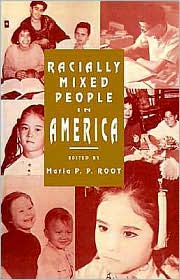New Faces in a Changing America: Multiracial Identity in the 21st CenturyPosted in Africa, Anthologies, Books, Brazil, Census/Demographics, Media Archive, Politics/Public Policy, Social Science, South Africa, United States, Women on 2009-10-16 03:06Z by Steven |
New Faces in a Changing America: Multiracial Identity in the 21st Century
SAGE Publications, Inc.
Paperback ISBN: 9780761923008
2001
432 pages
Edited by
Loretta I. Winters
California State University, Northridge
Herman L. DeBose
California State University, Northridge
How multiracial people identify themselves can have major consequences on their positions in their families, communities and society. Even the U.S. Census has recognized the rapidly increasing numbers of those who consider themselves multiracial, adding a new racial category to the 2000 Census form: two or more races.
New Faces in a Changing America: Multiracial Identity in the 21st Century examines the multiracial experience, its history and the political issues and consequences surrounding biracial and multiracial identity, bringing together top names in the field to give readers cutting edge views and insights gained from contemporary research.
This important new text follows the trail blazed by Maria Root, who contributes its opening chapter. An introduction places the issues of multiracial identity into context via a discussion of U.S. Census data and debates, providing an overview of the varied readings to come covering such topics as:
- Race as a social, rather than biological, construction
- The Multiracial Movement
- Racial/Ethnic Groups in America and Beyond
- Race, Gender & Hierarchy
- Gang Affiliation and Self-Esteem
- Black/White Interracial Couples and the Beliefs that Help Them to Bridge the Racial Divide
The book concludes with “The Multiracial Movement: Harmony and Discord,” by co-editor Loretta Winters, an epilogue putting the readings into perspective according to three models in the multiracial identity literature: the Multiracial Movement model, the Counter Multiracial movements model and the Ethnic Movement model.
Timely and comprehensive in its range of topics, this is an important resource for many audiences: students in Ethnic Studies, Race Relations and related courses; human service professionals including psychologists, counselors, social workers and school personnel and, importantly, multiracial individuals themselves.
| Forward | |
| Introduction | Herman L. DeBose |
| Acknowledgments | |
| PART I: RACE AS A SOCIAL CONSTRUCTION | |
| 1. Five Mixed Race Identities: From Relic to Revolution | Maria P. P. Root |
| 2. The New Multiracialism: An Affirmation or an End to Race as we Know It? | Mary Thierry Texeira |
| PART II: THE MULTIRACIAL MOVEMENT | |
| 3. New Faces, Old Faces: Counting the Multiracial Population (Click here to read.) | Ann Morning |
| 4. Multiracial Identity: From Personal Problem to Public Issue | Kimberly McClain DaCosta |
| 5. From Civil Rights to the Multiracial Movement | Kim M. Williams |
| 6. Census 2000: Assessments in Significance | Rainier Spencer |
| 7. Evolution of Multiracial Organizations: Where We Have Been & Where We Are Going | Nancy G. Brown & Ramona E. Douglas |
| PART III: RACIAL/ETHNIC GROUPS IN AMERICA & BEYOND | |
| 8. The Dilemma of Biracial People of African American Descent | Herman L. DeBose & Loretta L. Winters |
| 9. Check All That Apply: Trends & Perspectives Among Asian Descent Multiracials | Teresa Williams-Leon |
| 10. Beyond Mestizaje: The Future of Race in America | Gregory Velazco y Trianosky |
| 11. Colonization, Cultural Imperialism, and the Social Construction of American Indian Mixed Blood Identity | Karren Baird-Olson |
| 12. “Race,” “Ethnicity,” and “Culture” in Hawai’i: The Myth of the “Model Minority” State | Laura Desfor Edles |
| 13. Multiracial Identity in Global Perspective: The United States, Brazil, and South Africa | G. Reginald Daniel |
| PART IV: RACE, GENDER & HIERARCHY | |
| 14. Does Multiraciality Lighten? Me-too Ethnicity & the Whiteness Trap | Paul Spickard |
| 15. The Hazards of Visibility: “Biracial Women,” Media Images, and Narratives of Identity | Caroline A. Streeter |
| 16. Masculine Multiracial Comedians | Darby Li Po Price |
| PART V: SPECIAL TOPICS | |
| 17. Gang Affiliation & Self-Esteem: The Effects of a Mixed Heritage Identity | Patricia O’Donnell Brummett & Loretta I. Winters |
| 18. Black/White Interracial Couples & the Beliefs That Help Them to Bridge the Racial Divide | Kristyan M. Kouri |
| Epilogue: The Multiracial Movement: Harmony & Discord | Loretta I. Winters |
| Index | |
| About the Editors | |
| About the Contributors |






